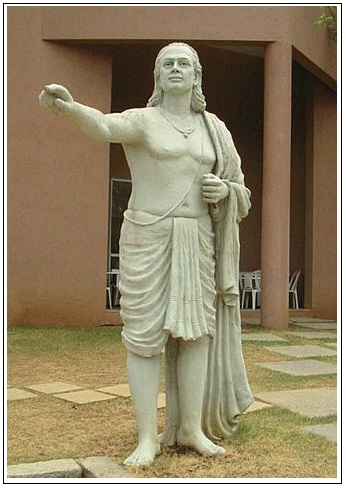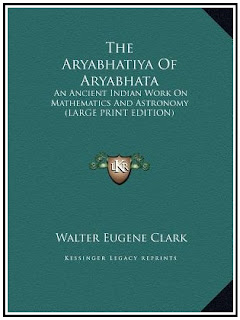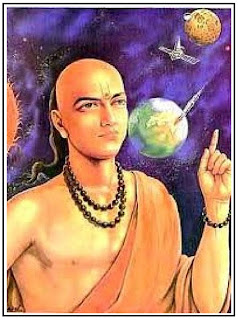Born: 476 A.D.
Died: 550 A.D.
A Brief Introduction:
Died: 550 A.D.
A Brief Introduction:
 |
| Statue of Aryabhata on the grounds of IUCAA(Inter-University Centre for Astronomy and Astrophysics), Pune. |
 |
| Geocentric And Heliocentric Theory |
Major Work Done:
The amazing astronomical deductions and calculations made by Aryabhatta are all the more astounding considering the fact that he possessed no modern instruments and equipment. He deduced that the earth is round. He also made the amazing declaration that the earth rotates on its own axis and it was this phenomenon that created day and night.
 |
| Solar Eclipse Description |
mythology. Aryabhatta demolished this false belief by forwarding the theory that eclipses occur because of the shadows cast by the earth and the moon.
| Lunar Eclipse Description |
In 499 A.D. he wrote his famous astronomical treatise Aryabhatiya. This treatise came to be acclaimed as a masterpiece and the Gupta ruler Buddhagupta made him head of the Nalanda University in recognition of his genius.
Aryabhatiya:
 |
| The Aryabhatiya Of Aryabhata book by Walter Eugene Clark |
ln the Ganita (calculations) section of Aryabhatiya, Aryabhatta devised an ingenious method for finding the lengths of chords of circles by using the half chord rather than the full chord method used by Greeks.
In mathematics Aryabhatta’s contributions are equally valuable. He gave the value of pi as 3.1416, for the first time declaring that it was but an approximation. He deduced this value on the basis of the calculation that the approximate circumference of a circle with diameter 20000 units is 62832.
He gave correct formulas for calculating the areas of a triangle and circle. He was also the first mathematician to give what later came to be called the tables of Sines. He also derived the methods for extracting square roots, summing arithmetic series and solving indeterminate equations of the type
ax - by = c.
His method to find a solution to indeterminate equations of this type is recognized the world over.
He also devised a novel method to express large numbers such as 100,000,000,000 in words. He developed the method to write unwieldy numbers in poetic form.
The concise but somewhat difficult-to-grasp Aryabhatiya also dealt with other aspects of mathematics and astronomical calculations, namely, geometry, mensuration, square root, cube root, progression and celestial sphere.
A Short Video About Aryabhatta's Inventions And DiscoveriesIn his old age Aryabhatta also wrote another treatise, Aryabhattasiddhanta. It is a book for day-to-day astronomical calculations as well as a guide to determine auspicious times for various rituals. To this day astronomical data provided in this text are used for preparing Panchangs (Hindu calendars).
Place Value System And Zero:
The place-value system, first seen in the 3rd century Bakhshali Manuscript, was clearly in place in his work. While he did not use a symbol for zero, the French mathematician Georges Ifrah explains that knowledge of zero was implicit in Aryabhata's place-value system as a place holder for the powers of ten with null coefficients.
However, Aryabhata did not use the Brahmi numerals. Continuing the Sanskritic tradition from Vedic times, he used letters of the alphabet to denote numbers, expressing quantities, such as the table of sines in a mnemonic form.
Some Other Works Of Aryabhatta:
Approximation Of π:
Aryabhata worked on the approximation for pi (π), and determined that π is irrational. In the second part of the Aryabhatiyam (gaṇitapāda 10), he writes:
caturadhikam śatamaṣṭaguṇam dvāṣaṣṭistathā sahasrāṇāmWhich means:
ayutadvayaviṣkambhasyāsanno vṛttapariṇāhaḥ.
"Add four to 100, multiply by eight, and then add 62,000. By this rule the circumference of a circle with a diameter of 20,000 can be approached."
This implies that the ratio of the circumference to the diameter is ((4 + 100) × 8 + 62000)/20000 = 62832/20000 = 3.1416, which is accurate to five significant figures.
It is speculated that Aryabhatta used the word āsanna (approaching), to mean that not only is this an approximation but that the value is incommensurable (or irrational). If this is correct, it is quite a sophisticated insight, because the irrationality of pi was proved in Europe only in 1761 by Lambert.
Sidereal rotation:
Aryabhatta calculated the sidereal rotation (the rotation of the earth referencing the fixed stars) as 23 hours, 56 minutes, and 4.1 seconds; the modern value is 23:56:4.091.
Sideral Year:
He calculated the length of the sidereal year at 365 days, 6 hours, 12 minutes, and 30 seconds (365.25858 days) is an error of 3 minutes and 20 seconds over the length of a year (365.25636 days).
Trigonometry:
His definitions of sine (jya), cosine (kojya), versine (utkrama-jya), and inverse sine (otkram jya) influenced the birth of trigonometry.
He was also the first to specify sine and versine (1 − cos x) tables, in 3.75° intervals from 0° to 90°, to an accuracy of 4 decimal places.






Such a wonderful Discovery by super Brain Aryabhatta.
ReplyDeleteAccording to sources zero is found by Brahmagupta and Aryabhata introduced decimal system, I guess
ReplyDelete